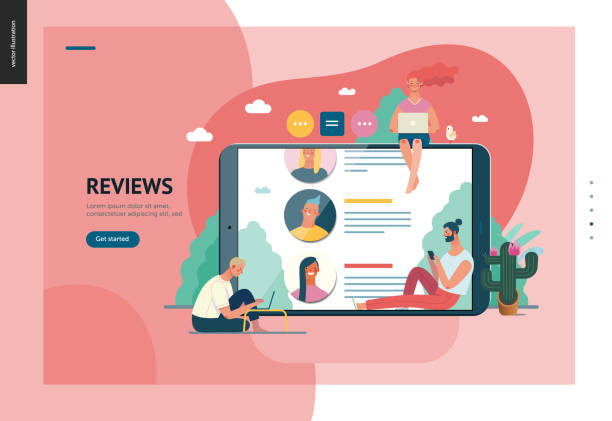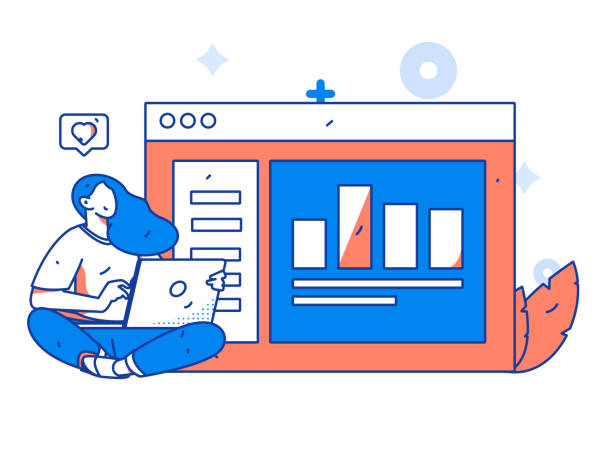Introduction to Responsive Design and Its Importance in the Digital Age

#Responsive_Web_Design #Responsive_Web #User_Experience
In today’s world, where users access the internet from various devices including smartphones, tablets, laptops, and even smart TVs, the importance of responsive web design becomes more apparent than ever.
It is no longer enough for a website to look good only on a computer screen; it must have the ability to adapt to any screen size and resolution.
This approach is the foundation of modern web design and allows websites to provide a consistent and optimal user experience without the need for separate versions for each device.
Imagine a potential customer viewing your website on their phone; if the content doesn’t display correctly, buttons are too small, or images are distorted, they will likely leave your website and go to a competitor that offers a better experience.
This is where the importance of responsive design emerges as a necessity, not a luxury.
A well-designed responsive website intelligently rearranges content, adjusts image and font sizes, and alters the layout of elements for the best readability and interaction.
This not only increases user satisfaction but also directly impacts your business’s conversion rates and online success.
In fact, Google is increasingly emphasizing responsive websites and prefers them in its search results, as Google’s primary goal is also to provide the best possible user experience.
Therefore, investing in responsive web design is investing in the future of your business.
Tired of losing customers due to poor e-commerce website design? With Rasaweb, solve this problem forever!
✅ Increase sales and visitor-to-customer conversion rates
✅ Smooth and engaging user experience for your customers⚡ Get a free consultation
Key Principles in Building Adaptive Websites

#Responsive_Principles #Responsive_Web #Flexible_Design
To achieve an effective responsive web design, understanding its fundamental principles is essential.
These principles include Fluid Grids, Flexible Images, and Media Queries.
Fluid grids use relative units like percentages for element widths instead of fixed pixel units.
This means that the width of a column or a section of the page will always be a percentage of the screen width, regardless of the screen size.
This method ensures that the website layout automatically adjusts with screen size changes and content fits correctly within the available space.
Flexible images operate similarly; by setting their maximum width (max-width) to 100%, they ensure that images never overflow their container and are always displayed in dimensions proportionate to the available space.
This approach prevents common issues such as unwanted horizontal scrolling or cropped images.
And Media Queries are considered the heart of responsive design.
This CSS3 feature allows developers to apply different styles based on device characteristics such as screen width, height, orientation (portrait or landscape), and even resolution.
For example, you can define that on screens smaller than 768 pixels, the navigation menu transforms into a hamburger button, or column layouts change from horizontal to vertical.
This combination of three principles forms the backbone of responsive web design and empowers developers to deliver flawless user experiences across all devices.
A deep understanding of these concepts is the first step in building powerful and future-proof websites.
Countless Benefits of Responsive Design for Businesses

#Responsive_Benefits #Increased_Traffic #Improved_SEO
Responsive web design is more than a trend; it’s a strategic investment for any business aiming to remain competitive in the online space.
One of its most prominent advantages is an improved user experience.
When users can easily view your website’s content on any device without the need for zooming or horizontal scrolling, the likelihood of them staying on your site, browsing other pages, and ultimately converting into customers significantly increases.
This seamless experience also strengthens customer loyalty.
Another benefit is improved SEO (Search Engine Optimization).
Google has officially stated that it prefers responsive websites and ranks them higher in its search results.
The reason is that a responsive website has only one URL, making it much easier for Google’s bots to crawl and index.
This helps prevent duplicate content issues and improves rankings.
Furthermore, reduced development and maintenance costs are also a significant advantage.
Instead of developing and maintaining multiple separate versions of a website (for desktop, mobile, and tablet), with responsive web design, there is only one codebase, which is much simpler to manage, update, and debug.
This directly leads to savings in time and resources.
Increased conversion rates are also a direct result of all the above benefits; a more user-friendly and better-performing website will ultimately lead to more sales, more sign-ups, or whatever other goals you have set for your business.
Finally, broader audience reach is another advantage, as your website will be accessible and appealing to anyone on any device.
| Feature | Responsive Design | Separate Mobile Site Design |
|---|---|---|
| URL | One URL for all devices | Multiple URLs (e.g., m.example.com) |
| Codebase | One shared codebase | Two or more separate codebases |
| Maintenance | Easier and less costly | More complex and costly |
| SEO | Improved and favored by Google | May lead to duplicate content issues |
| User Experience | Integrated and consistent | May vary between devices |
Tools Required for Developing Responsive Websites

#Responsive_Tools #Responsive_Framework #Responsive_Testing
For effective implementation of responsive web design, developers need a set of tools and frameworks that facilitate the process.
At the core of this process are HTML5 and CSS3, which are the main foundations of a website’s structure and appearance.
Advanced CSS3 features like Media Queries allow for the application of conditional styles.
But beyond these basic languages, many tools exist that increase the speed and quality of responsive design.
CSS frameworks like Bootstrap and Tailwind CSS are among the most popular choices.
Bootstrap, by providing a ready-to-use grid system, pre-built UI components, and responsive styles, helps developers quickly build responsive websites.
Tailwind CSS takes a different approach, offering a set of utility classes instead of ready-made components, which allows for very high customization.
The use of CSS preprocessors such as Sass or Less can also make managing large and complex stylesheets easier, with features like variables, functions, and mixins.
For testing and debugging responsive web design, browser developer tools (like Chrome or Firefox Developer Tools) are very useful, allowing you to view the website at various screen sizes and mobile device emulators.
Additionally, online services like Responsive Design Checker are useful for quick testing and viewing the website in different sizes without needing software installation.
Finally, image optimization tools such as TinyPNG or websites that enable the use of next-generation image formats (like WebP) are crucial for ensuring fast page loading on different devices, as loading speed is a key factor in user experience and SEO.
Are you concerned about your e-commerce website’s low conversion rate and not achieving your desired sales?
Rasaweb is your specialized solution for a successful e-commerce website.
✅ Significant increase in conversion rates and sales
✅ Professional and user-friendly design to attract customer satisfaction
⚡ Ready to transform your online sales? Get a free consultation!
The Role of User Experience (UX) in Responsive Website Design

#Responsive_User_Experience #Responsive_UX #User_Friendly_Website
When it comes to responsive web design, the critical role of User Experience (UX) cannot be overlooked.
Good UX means that users can easily navigate your website, find the information they need, and perform desired actions, without any frustration or hindrance.
In a responsive website, this experience must be consistent and optimized across all devices, from the smallest smartphone to the largest desktop monitor.
This means paying attention to details such as font and button sizes (which should be large enough to be easily tapped with a finger), sufficient spacing between elements to prevent accidental touches, and logical content organization to avoid excessive scrolling on small devices.
Content prioritization is a crucial principle in responsive UX; on smaller screens, it may be necessary to hide secondary content or place it in expandable sections to highlight the main content.
Furthermore, page loading speed is a critical UX factor.
Mobile users typically have slower internet connections, so optimizing images, reducing HTTP requests, and utilizing caching can significantly improve loading speed.
A slow website can drive users away, even with the best visual design.
Responsive web design is not just about resizing elements; it’s about rethinking how users interact with content in different contexts.
This includes designing intuitive navigation, mobile-friendly forms, and ensuring accessibility for all users, including those with special needs.
An excellent user experience on a responsive website not only increases customer satisfaction but also directly contributes to business goals, such as increasing conversion rates and reducing bounce rates.
The Impact of Responsive Design on SEO and Google Rankings

#Responsive_SEO #Google_Ranking #Mobile_Optimization
Responsive web design is no longer just an option but a requirement for success in SEO and Google rankings.
For years, Google has implemented Mobile-First Indexing as its primary approach for ranking websites.
This means that Google primarily uses the mobile version of your website to evaluate and index content.
If your website does not have a responsive design and provides a poor mobile user experience, this will directly negatively impact your rankings in search results, on both mobile and desktop devices.
A responsive website, by having only one URL, avoids duplicate content issues that can occur with separate mobile websites (like m.example.com).
This helps improve domain authority and better distribute link juice.
Furthermore, page loading time on mobile devices is a critical ranking factor.
Responsive websites that are correctly optimized can have higher loading speeds, especially if images and scripts are optimized for mobile.
Lower bounce rates and longer user dwell times on the website, which are a direct result of a good user experience across different devices, send other positive signals to Google, indicating the quality and high relevance of your website.
Additionally, responsive web design makes optimization easier for developers because they don’t need to manage two versions of SEO; only one SEO strategy is sufficient for a single website.
This contributes to operational efficiency and ensures that all your SEO efforts are focused on one path.
Common Challenges and Solutions in Implementing Responsive Design

#Responsive_Challenges #Responsive_Solutions #Responsive_Optimization
Implementing responsive web design, despite its numerous advantages, is not without its challenges, and developers may encounter obstacles.
One of the biggest challenges is image management.
High-quality images suitable for desktop displays can lead to slow loading on mobile devices.
The solution is to use responsive images, such as utilizing the srcset attribute in HTML5, which allows the browser to load the appropriate image based on screen size, or using optimized image formats like WebP.
Another challenge is the complexity of CSS code.
With an increasing number of breakpoints and conditional styles, CSS files can become very large and difficult to manage.
Using CSS preprocessors like Sass or Less, as well as adhering to Clean Code principles, can help manage this complexity.
Choosing the right framework is also a challenge; each framework has its own pros and cons, and an incorrect choice can lead to excessive code (bloat) or design limitations.
Before choosing, project requirements must be carefully assessed.
Testing and debugging across various devices and sizes can also be time-consuming, as it’s essential to ensure the website displays correctly under all conditions.
Using browser emulator tools and testing on actual devices is crucial.
Finally, bulky or complex content can be hard to organize on smaller devices.
In such cases, strategies like hiding certain elements on mobile or using accordions and tabs to organize content can be helpful.
Responsive web design requires a comprehensive approach and attention to detail to provide an optimal user experience across all platforms.
| Category | Tool/Framework | Primary Use |
|---|---|---|
| CSS Framework | Bootstrap | Rapid development of responsive websites with ready-made components |
| CSS Framework | Tailwind CSS | Creating custom designs using utility classes |
| CSS Preprocessor | Sass / Less | Easier management and optimization of large CSS files |
| Image Optimization | TinyPNG / WebP | Reducing image size without quality loss for faster loading |
| Testing Tools | Chrome DevTools / Responsive Checker | Simulating and testing website appearance on different sizes |
A Look at the Future of Web Design and Its Adaptability

#Future_of_Web_Design #Adaptive_Web #New_Trends
The future of responsive web design goes beyond merely resizing elements; it is moving towards a fully adaptive and intelligent web.
With the emergence of technologies like Progressive Web Apps (PWAs), which offer a native app-like experience in the browser, as well as the expansion of Augmented Reality (AR) and Virtual Reality (VR) on the web, the concept of responsiveness is evolving.
It’s no longer just about devices, but also about the context of use.
For example, a future-proof website not only adapts itself to screen size but also synchronizes with the user’s connection speed, remaining battery level, and even their location to provide the best experience.
The use of Artificial Intelligence (AI) and Machine Learning (ML) in responsive web design also holds great potential.
These technologies can be used to personalize content and layout based on user behavior in real-time, without requiring manual designer intervention.
This leads to the creation of websites that dynamically adapt to the individual needs of each user.
Furthermore, with the proliferation of wearable devices and the Internet of Things (IoT), websites must also be able to provide useful information and simple user interfaces on these new platforms.
This means that responsive web design must become much more flexible and modular.
On the other hand, emphasis on Performance will remain central, with tools like Google’s Core Web Vitals setting new standards for website speed and visual stability.
Ultimately, web design is moving towards a system that reacts not only to the device but also to the user and their environment, providing a seamless and incredibly personalized experience.
These developments paint an exciting outlook for web developers and users alike.
Are you dissatisfied with your e-commerce website’s low sales?
Rasaweb is your solution for a professional and high-selling e-commerce website.
✅ Significant increase in sales and revenue
✅ Easy and enjoyable shopping experience for customers
⚡ Get a free consultation from Rasaweb now!
Strategic Tips for Ordering a Successful Responsive Design

#Order_Responsive_Website #Choose_Web_Designer #Responsive_Strategy
If you intend to order a website with responsive web design for your business, knowing strategic tips can help you choose the right designer or development team.
The first step is setting clear goals.
What exactly do you expect from your website? Who are your target users, and what devices do they primarily use? Answers to these questions will help the design team propose the best solution for you.
The second tip is to review portfolios and experience.
Does the designer or company have a history of working on similar and successful projects in responsive design? Portfolios that function well across different devices are an indication of their capability.
Be sure to ask them what approaches and tools they use to ensure responsiveness.
Do not underestimate the importance of content.
Your content should be such that it displays well across different layouts and conveys the main message.
Consult with your design team about content strategy, including how images and videos will be displayed on smaller devices.
Also, pay attention to post-development support and maintenance.
A responsive website requires continuous updates and maintenance to keep pace with browser and device changes.
Does your service provider offer post-launch support? Another important question is, will the initial design be Mobile-First? This approach means designing the website first for mobile devices and then scaling it up for desktops, which generally leads to better results in responsiveness and performance.
Finally, clearly state your budget and timeline, and ensure that the contract includes full details of all services and project delivery stages.
By considering these points, you can have a successful and future-proof responsive web design.
Conclusion and Final Outlook on Responsive Design in Persian Web

#Responsive_Outlook #Persian_Web #Website_Future
In conclusion, it can be said that responsive web design is no longer an option, but an undeniable necessity for any business and website aiming to succeed in today’s digital world.
From improving user experience and increasing audience satisfaction to enhancing ranking in Google search results and reducing development costs, its benefits are countless and cannot be ignored.
With the ever-increasing use of mobile devices to access the internet, ignoring responsive design means losing a significant portion of the audience and business opportunities.
In the Persian web space, where a significant percentage of users connect to the internet via smartphones, the importance of responsive web design becomes even greater.
Iranian businesses that do not move in this direction will quickly fall behind their competitors.
The future of the web is one where websites intelligently and dynamically adapt to every device and context, providing the best possible user experience.
This includes not only screen size but also internet speed, location, and even personal user preferences.
Investing in responsive web design is an investment in accessibility, performance, and ultimately, the long-term success of your business in the digital ecosystem.
This process requires careful planning, the use of appropriate tools, and a deep understanding of user needs.
By adopting this approach, your website will not only perform better now but will also be ready for future challenges and opportunities, placing you on a path of continuous growth and innovation.
Frequently Asked Questions
| Question | Answer |
|---|---|
| What is Responsive Web Design? | It is an approach that ensures your website’s layout displays well on any device (such as mobile, tablet, and desktop) and adapts to the user’s screen size. |
| Why is responsive design important? | Improved user experience across different devices, increased traffic and conversion rates, better search engine rankings (SEO), and reduced need for developing separate mobile versions. |
| How is responsive design implemented? | By using CSS Media Queries to apply different styles based on device characteristics (like screen width), utilizing Fluid Grids, and Flexible Images. |
| What are the main technologies used in responsive design? | HTML5, CSS3 (especially Media Queries), and JavaScript. |
| What are the main benefits of responsive design? | Integrated user experience across different devices, easier website maintenance, better SEO (because Google prefers responsive sites), and saving time and cost compared to developing a mobile app or a separate site. |
And other services of Rasa Web Advertising Agency in the field of advertising
Smart Sales Automation: A combination of creativity and technology for campaign management through custom programming.
Smart Data Analysis: A professional solution to increase sales by focusing on customizing user experience.
Smart UI/UX: A fast and efficient solution for attracting customers, focusing on attractive user interface design.
Smart Sales Automation: A fast and efficient solution for increasing click-through rates, focusing on attractive user interface design.
Smart Marketing Automation: An effective tool for user engagement with the help of user experience customization.
And over hundreds of other services in the field of online advertising, advertising consultation, and organizational solutions
Online Advertising | Advertising Strategy | Advertorials
Resources
The Future of Responsive Design on the Web
Complete Guide to Responsive Design
The Evolution of Smart Browsers
Best Practices for Responsive Design
? With Rasaweb Afarin, build the future of your business in the digital world! For professional corporate website design and launching targeted digital marketing campaigns, contact us today.
📍 Tehran, Mirdamad Street, next to Central Bank, Kazeroon Southern Alley, Ramin Alley, No. 6

